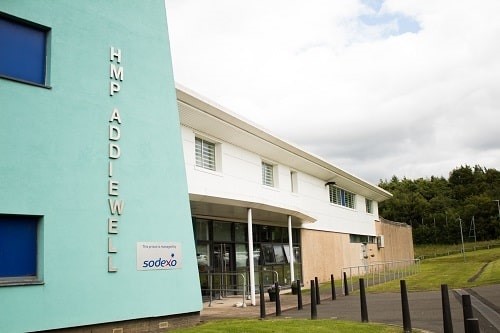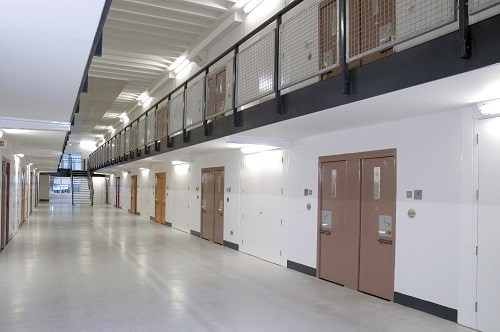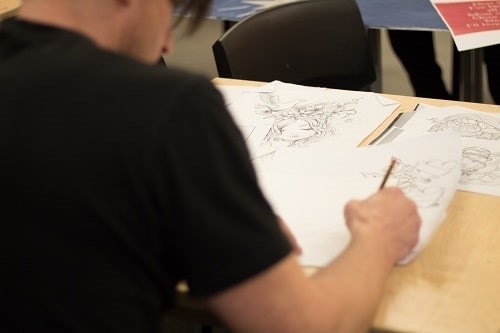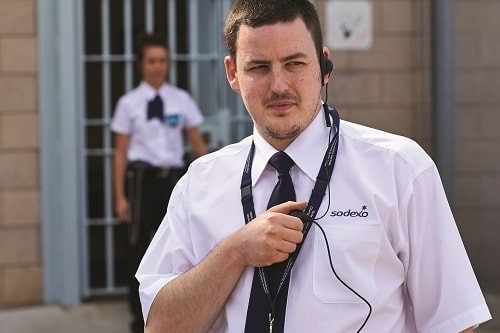Sodexo Justice Services was recently awarded the British Safety Council’s five star audit for five of its prisons. Belinda Liversedge is granted access behind the bars at HMP Addiewell, an all-male high security prison in Scotland, to find out how they did it.
Features
Raising the bar for prison safety: a case study
“We’re like a family; it’s a really different atmosphere to working anywhere else, when anything goes wrong everybody just mucks in. I’ve never come into work feeling unsafe.”
For anyone who might have preconceived ideas about prisons, the passion of the employees for their community at HMP Addiewell, a prison located near the village of Addiewell in West Lothian, Scotland, offers a different view.
As health and safety manager, Leigh McEwan, tells me, good team work is how things are done. It’s what helped the prison along with all five of those managed by Sodexo Justice Services, to meet the high standards of British Safety Council’s Five Star Safety, Health and Environmental Audit.
 704 men reside at HMP Addiewell, its high security category status referring to the high risk of escape
704 men reside at HMP Addiewell, its high security category status referring to the high risk of escape
A British Safety Council auditor will have spent around a week to get to know Addiewell and its safety team.
I am here for a mere morning, but never having seen a prison up this close, it feels daunting. To prepare for the visit, I’ve read about the issues in prisons, from overcrowding to poor living conditions, but the location here is the first to confound expectations. Set in pretty countryside on the site of a former paraffin works, it is sandwiched between Edinburgh and Glasgow. On arrival at the rural station, a tiny lane leads to the low buildings of the prison. Each day around 345 employees make their way to work here.
Addiewell is one of a portfolio of five prisons managed by Sodexo Justice Services. The others, in England, are: HMP Bronzefield, HMP Forest Bank, HMP Peterborough and HMP Northumberland. At the time of my visit there were 704 men at HMP Addiewell and its high security category status refers to the high risk of escape rather than, as is often wrongly assumed, about the seriousness of the crime committed.
It is a prison with a focus on learning and development, meaning the prisoners have access to trade workshops, gyms, libraries and education classrooms. Stenia Walker, deputy safety and risk manager at Sodexo Justice Services oversees two staff, Leigh and an administrator, and she is tasked with ensuring high standards across the prisons.
 Lomond Charlie, one of the residents’ wings Safety Management visited
Lomond Charlie, one of the residents’ wings Safety Management visited
Working with the British Safety Council for the audit is the culmination of a long relationship. Each year enables progress on their health and safety journey, and each audit has helped raise the bar of what can be achieved. “Six years ago it was about [managing] basic risks. Now it’s about achieving really good practice,” says Stenia.
Fire, the number one risk
This is not to say that the team aren’t kept on their toes every day to manage the main risks. Before I can pass through security, I have to leave my headphones behind, illustrating one of the top three risks – fire. “Fire is the number one risk within the safety remit. You’re in an area where you’re all locked in, so fire becomes a much bigger issue. We have a population of residents where behaviour is not always good, a lot of them have mental health issues and 99.9 per cent of the fires we do have are arson based,” says Stenia.
The residents use all sorts of things to try to start fires, including the wires from headphones. They will also prise apart vape machines or strip wire out of kettles: “Anything they can get their hands on, they use the wires and put them into the electric socket.” There have been two fires in residents’ rooms (cells) so far already this year, and 12 last year, so it’s an ever present, but managed risk.
A culture of respect
Both Leigh and Stenia are emphatic that the 704 are referred to as ‘residents’ rather than prisoners. “We tend not to call them prisoners – it’s residents – they don’t live in a cell, they live in a room and some of the prisoners don’t like that, it gives them an identity, they want to be a prisoner – and it’s them and us, and we try and break that down,” says Stenia. At Addiewell, even the language used is important in achieving rehabilitation – by giving residents self-respect to be ready for the outside world – while creating a safe community.
 Addiewell is a learning and development prison, meaning the prisoners have access to trade workshops, gyms, libraries and education classrooms.
Addiewell is a learning and development prison, meaning the prisoners have access to trade workshops, gyms, libraries and education classrooms.
Equally, none of the prison officers carry a baton, unlike many other prisons. “To me that changes the dynamic,” says Stenia. “As soon as you have a weapon, you can never build a relationship because that resident knows that you’ve got a weapon you can use if necessary. We don’t at all, it’s our ability to build relationships and that shows in the statistics. We have really safe prisons, we have many fewer incidents than a lot of the other public prisons,” says Stenia.
Residents are also involved in the prison’s safety strategies and they have forums where they can bring up issues. They also are responsible for safety inductions for new residents. “They’ll listen to other residents, we have two that are really good at delivering them, it includes health and safety training, fire awareness,” says Stenia. Later, she tells me that giving residents more responsibility is going to be a focus going forward.
“Quality of life, decency, social values – this is critical to what we are trying to do at Addiewell,” she says. “When you are a resident in our prison you’ve lost your freedom, that’s the punishment, but in that situation everyone has a feeling of wanting to get empowered.” The impulse to rebel is common in any institution, so increasing residents’ empowerment in a controlled way could be a game changer.
Violence and conflict
There is a focus on culture to manage safety, but there are also several safety tools. “We’ve got the three checks for safety which at the moment is the big thing,” says Stenia. This involves each staff member asking themselves before they begin work: ‘do I understand the job I have to do; secondly, do I have the right equipment and, thirdly, is my environment safe?’ “And if the answer is no to any of those you don’t progress, you speak to a manager. It might be ‘my safety shoes are a bit dodgy at the moment’ and they’ll get a replacement for you, so you can carry on.”
The prison also celebrates incident- free days, which Stenia says is better for morale than dwelling on number of incidents. All prison-facing staff are trained in control and restraint, and what is called the ‘five minute intervention’. This refers to the five-minute window a person has before a situation can escalate into violence. Everything is recorded on CCTV and they regularly watch incidents back to gain learnings, such as ‘cues and clues’ of anger erupting.
 Officers at Sodexo's prisons don't carry batons. "As soon as you have a weapon, you can never build a relationship."
Officers at Sodexo's prisons don't carry batons. "As soon as you have a weapon, you can never build a relationship."
A separate safer custody team manages the risk of violence, but there is a lot of background work to keep frontline staff safe. For example, assessing residents on arrival for their needs, such as if they have physical or mental disabilities.
This can determine where prisoners are located to reduce the likelihood of confrontation in the prison. “Each wing on site is dedicated so we’ve got wings for vulnerable prisoners, who will be on protection or sexual offences – if you mix them in with the normal population they may be targeted – there can be prison officers or police officers in prison, so they’re classed as vulnerable too,” says Stenia.
Up close with prison life
Touring the prison is when I get a view of safety in situ. There are five main sections to Addiewell: three housing blocks, a central entrance block and a compound and service yard.
We visit Lomond Charlie, one of the residents’ wings. Seeing a prison up close is an unsettling experience. There is a high-walled prison yard, where residents are allowed to exercise in for one hour in weekday mornings and weekends. There are obviously no windows to either look out of or let the sunshine in. One resident has covered an entire wall of his room with skillful drawings. “Some discover talents they never knew they had, it’s wonderful to see,” Stenia says.
It’s impossible to talk about safety at Addiewell without mentioning mental health. It is a huge issue in prisons. The Ministry of Justice latest figures show there were 120 suicides in prisons (in 2017, the last year available) and 40,161 incidents of self-harm – by any standards, a huge number given that the prison population is 86,674 adults (in England and Wales).
Separately, a Care Quality Commission report issued in October 2018 identified that poor mental health provision for prisoners and guards not trained to recognise problems were compounding the issue. “85 per cent of the population that comes in to Addiewell are reliant on substances – drugs, alcohol, tobacco – a lot have mental health issues,” says Stenia.
Fortunately, unlike the majority of prisons, mental health provision for the residents here are good. “We have a healthcare department, there’s detox support [for residents coming off drugs] such as methadone, nicotine patches, hypnotherapy, acupuncture, all sorts of things, yoga. And if the residents engage, it can transform their lives,” says Stenia.
 85 per cent of the population that comes in to Addiewell are reliant on substances
85 per cent of the population that comes in to Addiewell are reliant on substances
All staff are trained on the Talk to Me programme, which recognises that residents might open up to anyone – the cleaner or the person delivering their meal – and staff need to know what to say and what to do in those instances. In serious cases, they will raise a concern form, triggering a meeting with an NHS mental health nurse and relevant staff members plus the resident. “We all talk about what’s led them to that place, what we can do to help and any actions going forward to support them,” says Leigh.
Environmental challenges
Part of the tour includes lunch. This is not just my first experience of prison food, but it is when I learn about the environmental management work at Addiewell. “The integrated audit provided a really good gap analysis for environmental work,” says Stenia. It helped them to make changes, such as reducing the volume of food waste for composting by 50 per cent and there is zero sent to landfill. It’s also helped them to identify new areas to tackle.
For example, cutlery and plates are all reusable plastic now. But the next challenge is getting rid of plastic containers used for portion control. Equally, work needs to be done to remind staff not to throw away their re-usable plastic. Neil Quinn, the facilities manager, tells me: “It’s important we change that practice, which we will be working on over the next months through education and communications.”
Environmental challenges are different in all five prisons. In England all the prisons run off the National Grid for energy, at Addiewell, because of its remoteness, they have the challenge of power outages. Everything is orderly and clean in the immediate environment. A disrepair or graffiti might be left for weeks in public buildings, but not in prison. “Here it’s fixed quickly,” says Neil.
At the end of the visit I’m shattered. It’s just a fraction of the intense week it takes for the British Safety Council to assess suitability for a five star audit. “It’s an exhausting process, but always beneficial,” enthuses Stenia. After HMP Northumberland, the last one of the five to pass the five stars, was announced they were all ‘over the moon.’ “Directors are proud of their prisons, they love to get recognition on safety. And the British Safety Council Five Star Audit indicates quality and a standard.” This is a positive note on which to end the visit, and so I make my escape.
Find out more about the Five Star interagrated Audit here
FEATURES

Why line managers play a vital role in workplace wellbeing
By Marcus Herbert, British Safety Council on 03 September 2023
The behaviours of line managers can have a positive or negative impact on employee health, wellbeing and engagement, so it’s vital managers get staff feedback on whether their management style is supportive or negative, and have regular check-ins so workers can raise concerns about their wellbeing.

Watercooler Event to hone in on eight trends in employee health and wellbeing
By Claire Farrow, Make a Difference Events & Media on 15 April 2024
The free-to-attend Water Cooler Event at ExCeL London on 23–24 April will see more than 6,000 workplace experts coming together to explore the latest thinking, solutions and best practice for supporting and boosting employee wellbeing, diversity and workplace culture.

Sedentary working and how to combat the ‘sitting disease’
By Gavin Bradley, Active Working on 05 April 2024
Prolonged and excessive sitting poses a major risk to our health, but the Get Britain Standing campaign and On Your Feet Britain Day on 25 April are a great way of encouraging workers to sit less and move more.



